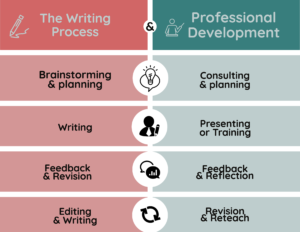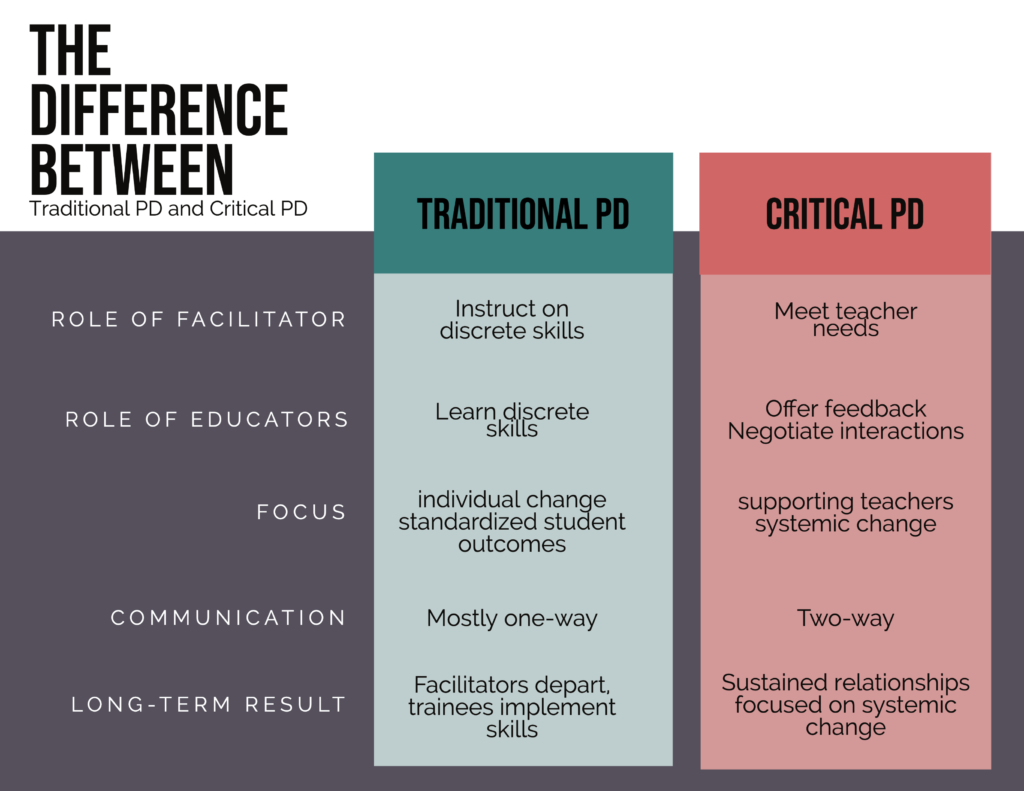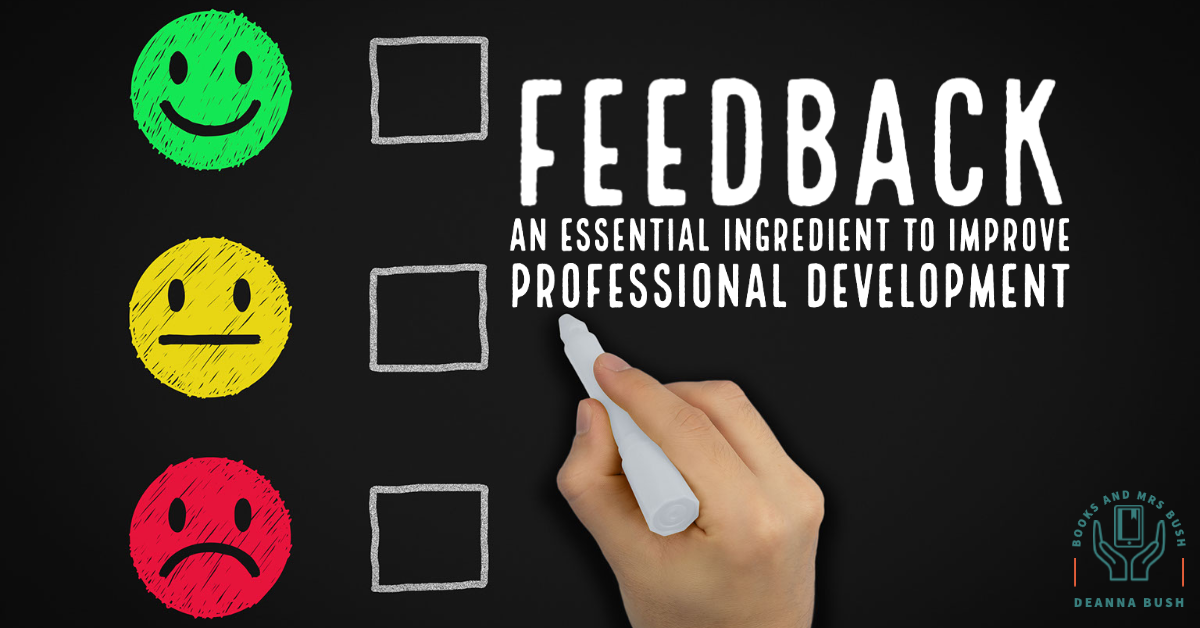As we learn more about professional development in education, common elements of effective professional development point emerge: it should be ongoing, align with the values and culture of the school, and meet the needs of all stakeholders. There are structural elements we can put into place that ensure that professional development is effective according to these criteria, such as using a coaching model or involving multiple stakeholders in the selection and planning of professional development. But, these elements only address the creation and implementation of professional development. If professional development were an essay, these elements would be pre-writing (brainstorming and organizing), and writing.

As any language arts teacher (and James Hattie enthusiast) can attest, we see the greatest growth in writing skills during the feedback and revision phases of the writing process. I suspect it’s the same with professional development. We often think of the professionals who train teachers as individuals who have reached the pinnacle of their career: that the best teachers become trainers and coaches. But, even if this were true, there is always room to grow; and feedback, reflection, and revision incorporated into professional development allows those who lead professional development trainings to benefit from the same growth opportunities that we provide students and teachers.
Do we Need to Improve PD?
The short answer is “yes.” PD as it currently exists can be hit or miss as far as effectiveness. In a 2021 article, Mike Schmoker explains that PD can often incur great expense for district but have minimal impact on instructional practices. He cites multiple examples, including two largely inneffective trainings, one costing $500 million, and a two year math initiative that cost immense amounts of time and money (Schmoker, 2021).
How can districts ensure that professional development does not become a costly waste of time and money? Schmoker provides four best practices to improve the effectiveness of professional development as measured by student achievement, and while these best practices seem logical, I would add that we also consider adding another element to the way in which we evaluate the quality of professional development: participant feedback.
Feedback to Improve PD
Most commonly, teacher training is evaluated by student performance. This indicator is useful and represents the end-goal of teacher training, but it also introduces additional variables that impact student performance such as whether individual students were hungry, tired, or otherwise preoccupied on the day they were assessed; or external elements such as seating, environmental factors, or individual psychological factors. While participant feedback isn’t the end-goal of teacher training, it should be a factor included in the process of evaluation and improvement.
So, how can feedback be used to meaningfully impact professional development? Providers of professional development for teachers can benefit from the swath of data and recommendations regarding how to implement effective feedback generally as part of evaluating and revising professional development. The Centers for Disease Control guidance for implementing and evaluating professional development emphasizes the importance of the evaluation phase of professional development. At the “Reaction” level of PD evaluation, the CDC suggests that providers evaluate participant satisfaction and if the training met staff needs by asking questions that would best be answered through feedback gathering, such as:
- “how satisfied were participants with the PD?
- What percentage of participants would recommend the training to other staff?
- What proportion of participating staff reported achieving at least one PD goal as a result of the training?
- What additional PD is needed by participants?” (CDC).
Among the topics facilitators of professional development may find useful to include in feedback are participants satisfaction with the initial training and follow up, content alignment with participants’ needs or goals, the learning environment, the age or content relevance of the materials, and additional needs. This information can be gathered via surveys and interviews following generalized best practices, to minimize elements that taint the responses trainers receive such as cognitive fatigue (which can be eliminated through careful question construction and short surveys), and inaccurate responses (which can be eliminated by avoiding double barreled questions and by allowing respondents to reply anonymously).
Responding to Feedback
University of Waterloo provides suggestions for getting the most out of feedback which culminate in assessing the value of the feedback and following up on the feedback (Centre for Teaching Excellence, 2020). Responses to feedback include maintaining an open mind about the feedback provided, ensuring understanding, reflection, and following up on the feedback. Feedback is a valuable tool that can make training more enjoyable and effective, and an important element in the process of developing strong professional development sessions.
CPD and Discursive Processes
Some types of professional development lend themselves to feedback and adaptation more than others. One specific model of professional development takes the concept of feedback and expands on it until the feedback becomes less of an addition to the end of the training and more an integral, ongoing part of it. Doing so requires structuring training in a less traditional way that shares authority within the training sessions more equally between trainers and trainees.
In 2020 research, Danielle Lillge describes a Critical approaches to Professional Development (CPD), a model of professional development that uses model that creates constant feedback in training by changing the structure of professional development entirely. CPD uses a method of circulating power reframes professional development as a team effort in which teachers and experts engage in seemingly unstructured (discursive) discussion-based learning and problem solving by allowing the professional development to progress in a discursive manner that ensures a constant flow of feedback and growth. Lillge explains that “focusing on these discursive processes enables facilitators and those who study facilitation to look differently for answers to a question that persists, even when teachers have access to high-quality professional learning content: How do skillful facilitators foster generative social and discursive spaces that best support colleagues’ literacy learning and, by extension, teaching?” (2020).

Whether the training used for professional development maintains a more traditional structure or a structure similar to CPD depends on the goals of the training, culture of the educational institution and resources available. However, all forms of professional development have in common the fact that there is a strong potential benefit of incorporating feedback from trainees into professional development planning. Simply put, no matter what form your professional development takes, it is likely that it would benefit from feedback.
Resources
Schmoker, M. (2021). The Obvious Path to Better Professional Development. Educational Leadership, 78(8), 65–69. https://www.ascd.org/el/articles/the-obvious-path-to-better-professional-development
Lillge, D. (2021). Facilitation Literacy: Circulating Power in Professional Learning Conversations With Teacher Colleagues. Journal of Adolescent & Adult Literacy, 64(4), 399–407. https://doi-org.ezproxy.spu.edu/10.1002/jaal.1106
In Praxis Group Inc, Branch, A. A. E. S. I., Alberta. School Improvement Branch, In Praxis Group Inc, Alberta, S. I. B. S., & In Praxis Group Inc Staff. (2006). Effective Professional Development. Government of Alberta, Alberta Education.
CDC. (2019, October 8). Guide to Evaluating Professional Development. Centers for Disease Control and Prevention. https://www.cdc.gov/healthyschools/tths/pd_guide.htm
Receiving and Giving Effective Feedback | Centre for Teaching. (2020, May 13). Centre for Teaching Excellence. University of Waterloo. https://uwaterloo.ca/centre-for-teaching-excellence/teaching-resources/teaching-tips/assessing-student-work/grading-and-feedback/receiving-and-giving-effective-feedback

Thanks Deanna! This was an interesting read! I liked your last section about discursive processes and the graphic that went along with it. Very useful information when planning PD. Thanks!
Deanna, I love the comparison to the writing process. You do such a great job in designing graphics that summarize key information in your solutions. Your section on the discursive process of PD has really struck my interest and I want to share it with my colleagues to see how it could fit within our existing PD programs. The sustained relationships of PD feels most critical to me and aligns with Thomas Guskey’s ideas. Thank you for sharing!
You did a wonderful job providing a detailed discussion on how feedback can be used to improve professional development. I think your section on responding to feedback is an important part of the feedback process.